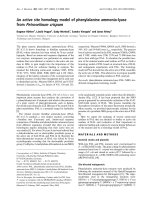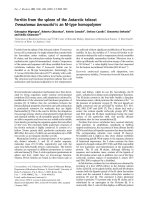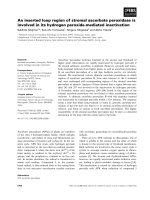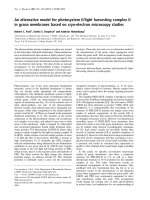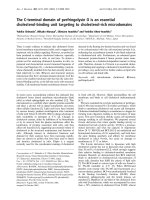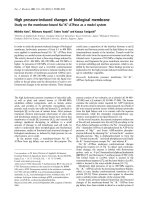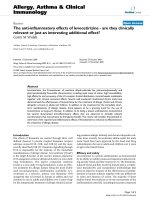Báo cáo y học: "An updated study-level meta-analysis of randomised controlled trials on proning in ARDS and acute lung injury" pps
Bạn đang xem bản rút gọn của tài liệu. Xem và tải ngay bản đầy đủ của tài liệu tại đây (538.14 KB, 9 trang )
RESEARCH Open Access
An updated study-level meta-analysis of
randomised controlled trials on proning in
ARDS and acute lung injury
Fekri Abroug
1*
, Lamia Ouanes-Besbes
1
, Fahmi Dachraoui
1
, Islem Ouanes
1
, Laurent Brochard
2,3,4
Abstract
Introduction: In patients with acute lung injury (ALI) and/or acute respiratory distress syndrome (ARDS), recent
randomised controlled trials (RCTs) showed a consistent trend of mortality reduction with prone ventilation. We
updated a meta-analysis on this topic.
Methods: RCTs that compared ventilation of adult patients with ALI/ARDS in prone versus supine position were
included in this study-level meta-analysis. Analysis was made by a random-effects model. The effect size on
intensive care unit (ICU) mortality was computed in the overall included studies and in two subgroups of studies:
those that included all ALI or hypoxemic patients, and those that restricted inclusion to only ARDS patients.
A relationship between studies’ effect size and daily prone duration was sought with meta-regression. We also
computed the effects of prone positioning on major adverse airway complications.
Results: Seven RCTs (including 1,675 adult patients, of whom 862 were ventilated in the prone position) were
included. The four most recent trials included only ARDS patients, and also applied the longest proning durations
and used lung-protective ventilation. The effects of prone positioning differed accordi ng to the type of study.
Overall, prone ventilation did not reduce ICU mortality (odds ratio = 0.91, 95% confidence interval = 0.75 to 1.2;
P = 0.39), but it significantly reduced the ICU mortality in the four recent studies that enrolled only patients with
ARDS (odds ratio = 0.71; 95% confidence interval = 0.5 to 0.99; P = 0.048; number needed to treat = 11). Meta-
regression on all stud ies disclosed only a trend to explain effe ct variation by prone duration (P = 0.06). Prone
positioning was not associated with a statistical increase in major airway complications.
Conclusions: Long duration of ventilation in prone position significantly reduces ICU mortality when only ARDS
patients are considered.
Introduction
The use of prone positioning during acute respiratory
distress syndrome (ARDS) ventilation has a robust
scientific ground and was evaluated in numerous rando-
mised controlled trials (RCTs). Despite signif icant and
sustained increase of oxygenation, prone positioning had
no impact on mortality [1-4]. Most of these studies
were underpowered, however, and meta-analyses
intended to overcome the effects of inadequate sample
sizes in individual RCTs failed to uncover any robust
trend toward improved overall survival using prone
positioning [5-9]. Yet from the first RCT evaluating
prone ventilation (Prone-Supine Study), Gattinoni and
colleagues highlighted in a post-hoc analysis that prone
positioning reduced the 10-day mortality of patients
with the highest disease severity (Simplified Acute Phy-
siology Score II ≥50) [1]. A similar message is conveyed
by selected analysis of the most severe patients in study-
level meta-analyses [7,8]. These findings were r ecently
reinforced by the conclusions of the Prone-Supine II
Study suggesting that the most severe ARDS patients
(defined by PaO
2
/FiO
2
ratio <100 mmHg) could derive
beneficial effects from prone ventilation with reduced
mortality [10]. Consequently, recent meta-analyses of
individual patient data obtained eithe r from all pub-
lished RCTs or from the four largest published RCTs
* Correspondence:
1
ICU CHU F. Bourguiba, 1st June 1955 Str, University of Monastir, Monastir
5000, Tunisia
Full list of author information is available at the end of the article
Abroug et al. Critical Care 2011, 15:R6
/>© 2011 Abroug et al.; licensee BioMed Central Ltd. This is an open access article distributed under the terms of the Creative Commons
Attribution License (http://crea tivecommons.org/licenses/by/2 .0), which permits unrestricted use, distribution, and reprod uction in
any medium, provided the origina l work is properly cited.
showed unquestionably that the subgroup of the
most severe patients (those with PaO
2
/FiO
2
ratio
<100 mmHg) had a significant reduction in mortality
with prone ventilation [11,12].
Meta-analysis of individual patient data helps to avoid
ecological bias, allows sufficiently powered subgroup
analysis, and even allows powerful and reliable evalua-
tion of treatment effects across individuals [13]. This
type of meta-analysis, however, does not solve all pro-
blems encountered in study-level meta-analyses. Indeed,
the accuracy of individual patient data depends on the
quality (conduct) and similarity (design) of primary stu-
dies, and heterogeneity might still be present if trials
are not sufficiently similar or carry potential sources of
bias [13]. Moreover, individual patient data meta-analy-
sis has frequently been shown to disclose divergent
results from those of study-level aggregate meta-analysis
[13,14].
In a previous aggregate meta-analysis we emphasised
the subst antial clinic al (rather than statistical) heter oge-
neity of primary studies, making it diffic ult to conduct a
study-level meta-analysis evaluating prone ventilation
[5]. This heterogeneity resulted merely from ecological
bias, which is caused by confounding across tri als [15].
Ecological bias usually arises from within-group variabil-
ity in covariates that may influence the outcome. In the
particular setting of early studies on prone ventilation,
ecological bias consisted of variable prone duration,
mixed severity of acute lung injury, variable time-lapse
between lung injury onset and inclusion, and lac k of
standardisation of co-interventions such as the lack of
protective lung ventilation. Early studies were also vul-
nerable to treatment contamination, by allowing for
crossover from one trial arm to another.
Given the large sample sizes of the initial studies,
the heterogeneity in terms of severity as well as
patient management heavily impacted the study-level
meta-analyses [5-9]. Of note, the most recent RCTs -
which learned from the shortcomings of early studies,
and were able to incorporate recent knowledge advances
regarding lung-protective ventilation - reached a consis-
tent design that was sharply different from that of the
large RCTs published earlier in the decade. Indeed, care-
ful examination of these trials shows that they s hare the
following common features: inclusion of the most severe
patients (ARDS only, excluding acute lung injury (ALI)
non-ARDS patients), and control fo r the most relevant
confounders - that is, proning duration (usually >17
hours/day) and use of lung-protective ventilation
[10,16,17]. Interestingly, each of these studies reported a
substantial reduction in absolute risk of mortality vary-
ing between 9 and 15% but lacked power to reject a
type II statistical error [10,16,17]. The possible minimi-
sation of ecological bias therefore makes these new
studies an interesting opportunity for a new updated
study-level meta-analysis.
In the present article, we update our recent meta-ana-
lysis of the effects of prone positioning on intensive care
unit (ICU) mortal ity . Along with a global meta-an alysis,
a s ubgroup meta-analysis is performed on the group of
studies that restricted inclusion to only adult ARDS
patients. We also explore the effects of proning
duration.
Materials and methods
Search strategy and study selection
The search strategy and se lection of studies are similar
to those described in our previous meta-analysis [5].
Pertinent studies were independently searched in
PubMed, EMBASE, CINAHL, and BioM edCentral
(updated 30 March 2010), using the following MeSH
and keyword terms: ‘acute respiratory distress syn-
drome’, ‘acute lung injury’, ‘acute respiratory failure’,
and ‘prone position ventilation ’.RCTsthatevaluated
mechanical ventilation in prone versus supine position-
ing in adults with acute respiratory failure, ALI, or
ARDS were included in the analysis. To minimise het-
erogeneity, we decided to keep only studies performed
in adults. The rationale of proning in adults is in part
based on homogenisation of the pleural pressure gradi-
ent and changes in chest wall compliance [18]. Whether
this also occurs in children with a different chest wall
configuration is not known. Studies conducted in infants
were therefore not included.
Data extraction and study characteristics
Three investigators (LO-B, FD and IO) independently
evaluated studies for inclusion and abstracted data on
methods and outco mes; disagreements were resolved by
consensus between investigators. We extracted the study
desi gn, type of population and disease severity (assesse d
by the PaO
2
/FiO
2
ratio), prone position duration on a
24-hour basis, and ICU mortality reported on an inten-
tion-to-treat basis. The methodological quality of each
trial was evaluated using the five-point scale (0 = worst
and 5 = best) as described by Jadad and colleagues [19].
Since all published meta-analyses have shown that
prone ventilation was effective on oxyg ena tion and pre-
vention of ventilator-associated pneumonia, while the
most recent one expressed doubts about its safety, we
focused our analysis mainly on the effects of prone ven-
tilation on both the ICU mortality and the procedure’s
complications.
Statistical methods
ICU mortality was analysed by means of a random-
effects model (assuming that the true effect could vary
from trial to trial) to compute individual odds ratios
Abroug et al. Critical Care 2011, 15:R6
/>Page 2 of 9
(ORs) with 95% conf idence intervals (CIs), and a pooled
summary effect estimate was calculated. Since a clear
change of primary study design has pro gressively
occurred along with incorporation in everyday practice
of new evidence gen erated by research, we evaluated the
impact of publication date on the overall effect of prone
ventilation by a cumulative meta-analysis. Indeed, this
type of presentation roughly evaluates the trend over
time for the overall effect of an intervention as new stu-
dies are published. We also compa red the effect size of
prone ventilation in two subgroups of studies: those that
included all ALI patients, and those that included the
most severe patients (ARDS patients). Noteworthy, this
separation allows also comparison of earlier (before
2006) versus recent studies (after 2005), and studies that
applied longer prone durat ion (≥17 hours/day) versus
studies applying shorter prone duration.
Statistical interaction (heterogeneity effect) was sought
by comparing the mean effect size for the two sub-
groups using the z test. Publication bias was assessed by
visual inspection of the funnel plot and the Begg and
Mazmudar rank correlation test. A relationship between
study results (the effect size) and daily prone duration
was sought with meta-regression. The incidence of com-
plications related to prone positioning was also com-
pared by means of a random-effects model. We analysed
the incidence of major airways events corresponding to
accidental extubation, a nd tracheal tube displacement
with or without selective intubation. Statistical signifi-
cance was set at the two-t ailed 0.05 level for hypothesis
testing and 0.10 for heterogeneity testing. Between-study
heterogeneity was assessed using the I
2
measure. The
meta-analysis was conducted using Comprehensive
Meta Analysis v2 (Biostat, Eaglewood, NJ, USA). The
present study was performed in compliance with the
PRISMA guidelines (Additional file 1) and the review
protocol has not been previously registered [20].
Results
Search results and trial characteristics
We identified 48 studies for detailed evaluation
(Figure 1). Seven RCTs eventually met criteria for inclu-
sion in the meta-analysis [1-3,10,16,17,21]. In compari-
son with our previous meta-analysis, one paediatric
study was not included according to our new selection
criteria [4], and three new RCTs issued during the past
2 years were added [10,17,21].
The study characteristics and m ethodological quality
are presented in Table 1. These seven studies included
1,675 patients, of whom 862 were ventilated in the
prone position for 7 to 24 hours/day. While early stu-
dies (published before 2006)includedpatients(n =
1,135) with a large spectrum of disease severity (ALI
andARDS),usedashortdurationofpronepositioning
(<17 hours), and did not use a protective lung ventila-
tion, the four most recent trials were quite similar
regarding patient severity (only ARDS patients were
included, n = 540), applied the longest proning duration
(17 to 24 hours/day), and ventilated patients with pro-
tective lung ventilation.
Effects on mortality
Pooling all studies was associated with a nonsignificant
9% reduction in ICU mortality ( OR = 0 .91, 95% CI =
0.75 to 1.1; P = 0.39; I
2
= 0%). Cumulative meta-analysis,
which sorts studies chronologically, shows a progressive
shift of the pooled summary effect of prone ventilation
from a negative to a positive effect starting with the
publication by Mancebo and colleagues, which was the
first RCT to include ARDS patients only (Figure 2) [16].
As anticipated, the effects of pro ne positioning were
different in both subgroups considered according to dis-
ease severity (Figure 3). Proning had no significant effect
in the earlier studies (three studies, n = 1,135 patients)
Figure 1 Flow diagram of the meta-analysis.
Abroug et al. Critical Care 2011, 15:R6
/>Page 3 of 9
that included patients with variable disease severity -
that is, all ALI or hypoxemic patients (OR = 1.05; 95%
CI = 0.82 to 1.34; P =0.7;I
2
= 0%) - while it signifi-
cantly reduced the ICU mortality rate in the four most
recent studies (n = 540 patients) that included only
patients with ARDS (OR = 0.71; 95% CI = 0.5 to 0.99;
P = 0.048; number needed to treat = 11; I
2
= 0%) . The z
test of interaction was not significant (z =1.87;P =
0.06), indicating that a heterogeneity of treatment effects
between both subgroups was not certain. Funnel plot
inspection did not suggest publication bias, and Begg’s
rank correlation test was not statistically significant
(P = 0.23).
The result of a meta-regression that assessed the re la-
tionship between prone duration and effect size in
included studies is presented in Figure 4. There was
only a nonsignificant trend to explain effect size varia-
tion by actual prone duration (z = -1.88; P = 0.06).
Adverse events
All included RCTs reported dat a regarding airway com-
plications related to prone positioning. The prone
Table 1 Characteristics of the included studies
Trial Disease PaO
2
/
FiO
2
ratio
SAPS
II
Population Prone
(n)
Supine
(n)
Actual
prone
duration/
day
(hours)
Crossover
allowed
Protective
lung
ventilation
Jadad
score
Gattinoni_2001 [1] ALI/ARDS (6%/94%) 127 40 304 152 152 7 Yes No 3
Guerin_2004 [2] ALI/ARDS (21%/31%) and
other causes of ARF
(pneumonia; acute on chronic
ARF; CPE, coma)
153 46 791 413 378 8 Yes No 3
Voggenreiter_2005
[3]
ALI/ARDS (45%/55%) (trauma) 222 NA 40 21 19 11 No Yes 3
Mancebo_2006
[16]
ARDS 145 41 136 76 60 17 Yes Yes 3
Chan_2007 [21] ARDS 109 NA 22 11 11 24 No Yes 1
Fernandez_2008
[17]
ARDS 120 38 40 21 19 20 Yes Yes 3
Taccone_2009 [10] ARDS 113 40 342 168 174 18 Yes Yes 3
Total/mean 141 ±
39
1,675 862 813 15 ± 6
ALI, acute lung injury; ARDS, acute respiratory distress syndrome; ARF, acute respiratory failure; CPE, cardiogenic pulmonary oedema; SAPS II, Simplified Acute
Physiology Score II.
6WXG\QDPH &XP XODWLYHVWDWLVWLFV &XP XODWLYHRGGVUDWLR &,
/RZHU 8SSHU
3RLQW OLPLW OLPLW S9DOXH
*DWWLQRQLB
*XHULQB
9RJJHQUHLWHUB
0DQFHERB
&KDQB
)HUQDQGH]B
7DFFRQHB
)DYRXUV3URQH )DYRXUV6XSLQH
Figure 2 Cumulative meta-analysis of prone ventilation on intensive care unit mortality. The fi rst row show s the eff ect based on one
study, the second row shows the cumulative effects based on two studies, and so on. CI, confidence interval.
Abroug et al. Critical Care 2011, 15:R6
/>Page 4 of 9
positioning was associated with a nonsignificant increase
in the incidence of accidental extubation, sel ecti ve intu-
bation, or tracheal tube displacement (OR = 1.16; 95%
CI = 0.75 to 1.78; P = 0.5) (Figure 5). The heterogenei ty
among trials was not significant (I
2
= 15%, P = 0.31).
Discussion
The current meta-analysis shows that global analysis of
RCTsassessingventilationinthepronepositioninALI/
ARDS patients does not show a significant benefit on
ICU mortality. The subgroup analysis stratified on the
type of included patients in primary studies, however,
disclosed a statistically significant reduction in mortality
in the studies that restricted inclusion to only patients
with ARDS, and not in those also enrolling patients with
less disease s everity. The comparison of the mean effect
size between subgroups was close to significance (P =
0.06), however, which does not allow one to ensure that
the effects of proning were significantly different between
subgroups. Another confounder may also be the daily
duration of ventilation in the prone position (P = 0.06).
Prone positioning was not associated with an increase in
major airway complications. The current study-level
meta-analysis confirms and reinforces recent findings of
individual patient data meta-analyses made by Sud and
colleagues and Gattinoni and colleagues [11,12].
In many meta-analyses, the inclusion criteria are so
broad that a certain amount of diversity among studies
is inevitable. A study-level meta-analysis should antici-
pate this diversity and interpret the findings according
to the results dispersion across the primary studies. We
therefore applied the random-effects model, and com-
puted a summary effect in subgroups of studies enrol-
ling patients of variable lung injury severity, yielding
important information on the peculiar e ffects of prone
ventilation in the most severe patients.
A way to fully account for the ecological bias inherent
to diversity of designs in primary studies is the perfor-
mance of a meta-analysis using individual patient data
[13]. Indeed, previous inferences on prone ventilation
benefits for the most severe hypoxemic patients were
recently confirmed by the meta-analyses from Sud and
colleagues and from Gattinoni and colleagues showing
reduced mortality rate in patients with PaO
2
/FiO
2
ratio
<100 mmHg [11,12]. This threshold was considered pro-
spectively only in the study by Taccone and colleagues
[10],however,whileseparation on this threshold basis
was mostly retrospective for the other trials. Owing to
increased risks of untoward effects, the authors recom-
mended considering prone ventilation only in the most
severe hypoxemia (despite a significant benefit up to
PaO
2
/FiO
2
ratio = 140 mmHg).
Our study used a different meta-analysis approach and
stratified subgroups of studies according to the disease
severity of included patients, rather than performing a
subgroup analysis of included patien ts. This study
Figure 3 Effects of prone ventilation on intensive care unit mortality. Point estimates (by random-effects model) are reported separately for
the groups of studies that included both acute lung injury (ALI) and acute respiratory distress syndrome patients (ARDS), those that included
only ARDS patients, and the pooled overall effects of all meta-analysis-included patients. CI, confidence interval.
Abroug et al. Critical Care 2011, 15:R6
/>Page 5 of 9
Figure 4 Meta-regression analysis of effects of prone duration (actually applied in included studies) on mortality. Log odds ratio plotted
according to prone duration with the summary fixed-effects meta-regression (z = -1.88; P = 0.06). Each study is represented by a circle
proportional to its weight in the meta-analysis reflecting the greatest impact on the slope of the regression line.
Figure 5 Incidence of major airway complications. CI, confidence interval.
Abroug et al. Critical Care 2011, 15:R6
/>Page 6 of 9
reached the same conclusions as individual patient data
meta-analyses, although our findings suggest that the
benefits can go beyond the recommended threshold and
concern all patients meeting ARDS criteria. A study-
level meta-analysis like ours could therefore be an alter-
native for clinicians to detect true intervention effects
(signals) despite differences among studies regarding
participants, interventions, and co-interventions (noise)
[22]. We should, however, recognise that such meta-
analysis necessarily suffers some shortcomings - such as
mixing in the same subgroup the early study by Gatti-
noni and colleagues [22], which included almost 93%
ARDS patients, and that by Guerin and colleagues [22],
which included only 30% of ARDS patients.
It is also difficult to control for important confounders
such as the differences in prone duration, ventilation
strategy, or associated treatments. Indeed, studies that
included only ARDS patients also implemented lung-
protective ventilation and longer prone duration, making
it difficult to ascribe the observed reduction in ICU
mortality to only one of these variables. Lung-protect ive
ventilation has proved to lessen ventilation-induced lung
injury and to reduce mortality, while longer prone dura-
tion helps to increase lung recruitment and enhances
gas exchange [23,24]. Following Gattinoni and collea-
gues, however, we should admit that a strong physiolo-
gical ratio nale underlies the fa ct that only the most
severe forms of ALI (namely p atients with ARDS) have
physiological conditions for proning efficacy and might
derive clinical benefit from prone ventilation [12].
Patients with ARDS indeed have a higher percentage of
potentially recruitable lung, greater amounts of lung
oedema, and a small portion of a erated lung [25]. Our
working hypothesis prompting stratification of included
studies according to the severity of acute lung injury
(ARDS studies versus ALI/ARDS studies) therefore
seems the most likely to account for the observed
reduction in mortality in the ARDS subgroup.
The fact that the test of interaction yielded only a
trend to different mean ef fect size of prone ventilation
in the subgroup of ARDS patients when compared with
studies that inc luded all ALI is not surprising given that
studies including ALI patients also enrolled a substantial
proportion of patients with ARDS. Without specific stu-
dies enrolling only ALI non-ARDS patients, this type of
effect comparison may be difficult. Apart from a type II
statistical error, the nonsignificant test of interaction
might a lso reflect a true lack of heterogeneity of prone
ventilation effects. The use of confidence intervals is
helpful to solve this uncertainty [26]. The 95% CI actu-
ally represents the range within which the true treat-
ment effect falls 95% of the time. In the subgroup of
studies enrolling only ARDS patients, the CI around the
point estimate suggests that the reduction of mortality
by prone ventilation could not be less than 1%. Simi-
larly, the CI boundaries for the effect of prone ventila-
tion in ALI/ARDS studies do not exclude a reduction by
18% in the mortality in such patients.
Our cumulative meta-analysis shows that beneficial
effects of prone ventilation have progressively become
apparent as ne w studies have been published. This fin d-
ing suggests that the gradual incorporation of research
advan ces (protective lung ventilation, inclusion of homo-
geneous groups of severity, standardisation of length of
proning,andsoforth)influencedthetrendtowardan
apparent benefit from prone positioning. This cumulative
meta-analysis also shows that the size effect of prone
ventilation on mortality has become almost constant
since 2006 following the study by Mancebo and collea-
gues [16]. Subsequent studies have merely contributed to
improve precision of this effect as reflected by a progres-
sive narrowing of the confid ence interval. Increased pre-
cision rather than substantial alteration in size effect is
probably what would be added by any new study on
prone ventilation. Furthermore, such a study would be
difficult to complete given inclusion barriers encountered
by most of the recent RCTs. Meanwhile, the present
aggre gate meta-analysis and the recent individual patient
data meta-analyses provide compelling evidence to
recommend prone ventilation in ARDS patients.
Our meta-analysis did not disclose a statistically signif-
icant increase in major airway complications of prone
positioning. The most recent RCT (Prone-Supine II
Study), however - which should be regarded as the most
reliable reflection of real-life practice - recorded a higher
incidence of adverse events associated with prone posi-
tioning [10]. This concerned not only airway complica-
tions but also the need for increased sedation, transient
desaturation or hy potension, and displacement of vascu-
lar lines. Accordingly, caution should be kept during the
manoeuvre - which should be applied only in the most
severe patients.
The survival difference between ALI/ARDS studies
and only ARDS studies might have additional possible
contributors, other than the disease severity. The ALI/
ARDS studies are the older studies, characterised by sev-
eral methodological differences such as the absence of
relevant co-treatm ents (lung-protective mechanical ven-
tilation st rategy), other criteria of enrolment (time win-
dow between ARDS criteria and enrolment), and so
forth. The main difference is that the length of the
proning treatment - which may constitute an important
determinant of the survival benefit - is profoundly dif-
ferent between older studies (shorter duration) and
newer studies (longer duration). Indeed, alveolar recruit-
ment in the prone position is a time-dependent phe-
nomenon [23]. Our study therefore cannot ascertain
whether the en rolment criteria by themselves explain the
Abroug et al. Critical Care 2011, 15:R6
/>Page 7 of 9
results, and suggests that proning duration also played a
role. We addressed the practical issue of the optimal
proning duration by a meta- regression anal ysis. We
found only a trend towards an interaction between longer
proning duration and reduction in mortality. The initial
studies by Guerin and colleagues [2] and Gattinoni and
colleagues [1] had the greatest impact on the slope of the
regression line. The sub group of studies incl uding only
ARDS patients also applied the longest proning durations
(17 to 24 hours/day). Hence, although proning duration
seemstoplayaroleintheoutcomeeffect,thepresent
analysis cannot definitely confirm this effect.
Conclusions
The present study-level meta-analysis based on an
observation (each of the most recent RCTs reported a
substantial, although nonsignificant, reduction in ICU
mortality by prone ventilation) and a working hypothesis
(only ARDS patients would derive benefit from prone
ventilation) tried to overcome primary trial heterogene-
ity by a subgroup meta-analysis of studies that restricted
inclusion to only ARDS. This meta-analysis shows that
prone ventilation significantly reduces ICU mortality in
ARDS patients and suggests that long prone durations
should be applied.
Key messages
• The use of prone positioning during ARDS ventilation
has a robust scientific ground.
• Available RCTs that were frequently underpowered
failed to document an impact on mortality mainly
because they included patients with a wide spectrum of
disease (ALI and ARDS) and applied variable length of
prone positioning.
• Study-level meta-analyses published so far only sug-
gested beneficial effects on mortality.
• Meta- analyses of individual patient data have
recently shown that prone positioning could reduce ICU
mortalityinthesubgroupofthemostseverepatients
(PaO
2
/FiO
2
ratio <100 mmHg).
• Using a subgroup analysis focusing on trials that
restricted inclusion to only ARDS patients, our study-
level meta-analysis shows that prone positioning reduces
ICU mortality in patients with ARDS.
Additional material
Additional file 1: PRISMA checklist. Checklist according to the PRISMA
guidelines.
Abbreviations
ALI: acute lung injury; ARDS: acute respiratory distress syndrome; CI:
confidence interval; FiO
2
: inspiratory fraction of oxygen; ICU: intensive care
unit; PaO
2
: arterial partial pressure of oxygen; OR: odds ratio; RCT:
randomised controlled trial.
Author details
1
ICU CHU F. Bourguiba, 1st June 1955 Str, University of Monastir, Monastir
5000, Tunisia.
2
Réanimation Médicale, AP-HP, Groupe hospitalier Albert
Chenevier - Henri Mondor, Avenue du Général, Créteil, France.
3
Université
Paris 12, Faculté de Médecine, Créteil, France.
4
INSERM unit 955, Equipe 13,
Créteil, France.
Authors’ contributions
FA conducted the literature searches, selected studies, extracted data,
assessed study quality, prepared initial and subsequent drafts of the
manuscript, and integrated comments from other authors into revised
versions of the manuscript. LO-B, FD, and IO screened abstracts, selected
studies meeting inclusion criteria, extracted data, and assessed study quality.
FA and LO-B carried out the statistical analyses with input from IO, FD and
LB. LB provided methodological guidance on drafting the manuscript. All
authors read and approved the final manuscript.
Competing interests
The authors declare that they have no competing interests.
Received: 27 April 2010 Revised: 8 July 2010 Accepted: 6 January 2011
Published: 6 January 2011
References
1. Gattinoni L, Tognoni G, Pesenti A, Taccone P, Mascheroni D, Labarta V,
Malacrida R, Di Giulio P, Fumagalli R, Pelosi P, Brazzi L, Latini R: Effect of
prone positioning on the survival of patients with acute respiratory
failure. N Engl J Med 2001, 345:568-573.
2. Guerin C, Gaillard S, Lemasson S, Ayzac L, Girard R, Beuret P, Palmier B,
Le QV, Sirodot M, Rosselli S, Cadiergue V, Sainty JM, Barbe P, Combourieu E,
Debatty D, Rouffineau J, Ezingeard E, Millet O, Guelon D, Rodriguez L,
Martin O, Renault A, Sibille JP, Kaidomar M: Effects of systematic prone
positioning in hypoxemic acute respiratory failure: a randomized
controlled trial. JAMA 2004, 292:2379-2387.
3. Voggenreiter G, Aufmkolk M, Stiletto RJ, Baacke MG, Waydhas C, Ose C,
Bock E, Gotzen L, Obertacke U, Nast-Kolb D: Prone positioning improves
oxygenation in post-traumatic lung injury - a prospective randomized
trial. J Trauma 2005, 59:333-341, discussion 341-343.
4. Curley MA, Hibberd PL, Fineman LD, Wypij D, Shih MC, Thompson JE,
Grant MJ, Barr FE, Cvijanovich NZ, Sorce L, Luckett PM, Matthay MA,
Arnold JH: Effect of prone positioning on clinical outcomes in children
with acute lung injury: a randomized controlled trial. JAMA 2005,
294:229-237.
5. Abroug F, Ouanes-Besbes L, Elatrous S, Brochard L: The effect of prone
positioning in acute respiratory distress syndrome or acute lung injury: a
meta-analysis. Areas of uncertainty and recommendations for research.
Intensive Care Med 2008, 34:1002-1011.
6. Tiruvoipati R, Bangash M, Manktelow B, Peek GJ: Efficacy of prone
ventilation in adult patients with acute respiratory failure: a meta-
analysis. J Crit Care 2008, 23:101-110.
7. Alsaghir AH, Martin CM: Effect of prone positioning in patients with acute
respiratory distress syndrome: a meta-analysis. Crit Care Med 2008,
36:603-609.
8. Kopterides P, Siempos II, Armaganidis A: Prone positioning in hypoxemic
respiratory failure: meta-analysis of randomized controlled trials. J Crit
Care 2009, 24:89-100.
9. Sud S, Sud M, Friedrich JO, Adhikari NK: Effect of mechanical ventilation in
the prone position on clinical outcomes in patients with acute
hypoxemic respiratory failure: a systematic review and meta-analysis.
CMAJ 2008, 178:1153-1161.
10. Taccone P, Pesenti A, Latini R, Polli F, Vagginelli F, Mietto C, Caspani L,
Raimondi F, Bordone G, Iapichino G, Mancebo J, Guerin C, Ayzac L,
Blanch L, Fumagalli R, Tognoni G, Gattinoni L: Prone positioning in
patients with moderate and severe acute respiratory distress syndrome:
a randomized controlled trial. JAMA 2009, 302:1977-1984.
11. Sud S, Friedrich JO, Taccone P, Polli F, Adhikari NK, Latini R, Pesenti A,
Guerin C, Mancebo J, Curley MA, Fernandez R, Chan MC, Beuret P,
Voggenreiter G, Sud M, Tognoni G, Gattinoni L: Prone ventilation reduces
Abroug et al. Critical Care 2011, 15:R6
/>Page 8 of 9
mortality in patients with acute respiratory failure and severe
hypoxemia: systematic review and meta-analysis. Intensive Care Med 2010,
36:585-599.
12. Gattinoni L, Carlesso E, Taccone P, Polli F, Guerin C, Mancebo J: Prone
positioning improves survival in severe ARDS: a pathophysiologic review
and individual patient meta-analysis. Minerva Anestesiol 2010, 76:448-454.
13. Reade MC, Delaney A, Bailey MJ, Harrison DA, Yealy DM, Jones PG,
Rowan KM, Bellomo R, Angus DC: Prospective meta-analysis using
individual patient data in intensive care medicine. Intensive Care Med
2010, 36:11-21.
14. Riley RD, Lambert PC, Abo-Zaid G: Meta-analysis of individual participant
data: rationale, conduct, and reporting. BMJ 2010, 340:c221.
15. Berlin JA, Santanna J, Schmid CH, Szczech LA, Feldman HI: Individual
patient- versus group-level data meta-regressions for the investigation
of treatment effect modifiers: ecological bias rears its ugly head. Stat
Med 2002, 21:371-387.
16. Mancebo J, Fernandez R, Blanch L, Rialp G, Gordo F, Ferrer M, Rodriguez F,
Garro P, Ricart P, Vallverdu I, Gich I, Castano J, Saura P, Dominguez G,
Bonet A, Albert RK: A multicenter trial of prolonged prone ventilation in
severe acute respiratory distress syndrome. Am J Respir Crit Care Med
2006, 173:1233-1239.
17. Fernandez R, Trenchs X, Klamburg J, Castedo J, Serrano JM, Besso G,
Tirapu JP, Santos A, Mas A, Parraga M, Jubert P, Frutos F, Anon JM,
Garcia M, Rodriguez F, Yebenes JC, Lopez MJ: Prone positioning in acute
respiratory distress syndrome: a multicenter randomized clinical trial.
Intensive Care Med 2008, 34:1487-1491.
18. Pelosi P, Tubiolo D, Mascheroni D, Vicardi P, Crotti S, Valenza F, Gattinoni L:
Effects of the prone position on respiratory mechanics and gas
exchange during acute lung injury. Am J Respir Crit Care Med 1998,
157:387-393.
19. Jadad AR, Moore RA, Carroll D, Jenkinson C, Reynolds DJ, Gavaghan DJ,
McQuay HJ: Assessing the quality of reports of randomized clinical trials:
is blinding necessary? Control Clin Trials 1996, 17:1-12.
20. Moher D, Liberati A, Tetzlaff J, Altman DG: Preferred reporting items for
systematic reviews and meta-analyses: the PRISMA statement. Ann Intern
Med 2009, 151:264-269, W264.
21. Chan MC, Hsu JY, Liu HH, Lee YL, Pong SC, Chang LY, Kuo BI, Wu CL:
Effects of prone position on inflammatory markers in patients with
ARDS due to community-acquired pneumonia. J Formos Med Assoc 2007,
106:708-716.
22. Davidoff F: Heterogeneity is not always noise: lessons from
improvement. JAMA 2009, 302:2580-2586.
23. Reutershan J, Schmitt A, Dietz K, Unertl K, Fretschner R: Alveolar
recruitment during prone position: time matters. Clin Sci (Lond) 2006,
110:655-663.
24. Ventilation with lower tidal volumes as compared with traditional tidal
volumes for acute lung injury and the acute respiratory distress
syndrome. The Acute Respiratory Distress Syndrome Network. N Engl J
Med 2000, 342:1301-1308.
25. Gattinoni L, Caironi P, Cressoni M, Chiumello D, Ranieri VM, Quintel M,
Russo S, Patroniti N, Cornejo R, Bugedo G: Lung recruitment in patients
with the acute respiratory distress syndrome. N Engl J Med 2006,
354:1775-1786.
26. Wyer PC, Keitz S, Hatala R, Hayward R, Barratt A, Montori V, Wooltorton E,
Guyatt G: Tips for learning and teaching evidence-based medicine:
introduction to the series. CMAJ 2004, 171:347-348.
doi:10.1186/cc9403
Cite this article as: Abroug et al.: An updated study-level meta-analysis
of randomised controlled trials on proning in ARDS and acute lung
injury. Critical Care 2011 15:R6.
Submit your next manuscript to BioMed Central
and take full advantage of:
• Convenient online submission
• Thorough peer review
• No space constraints or color figure charges
• Immediate publication on acceptance
• Inclusion in PubMed, CAS, Scopus and Google Scholar
• Research which is freely available for redistribution
Submit your manuscript at
www.biomedcentral.com/submit
Abroug et al. Critical Care 2011, 15:R6
/>Page 9 of 9


